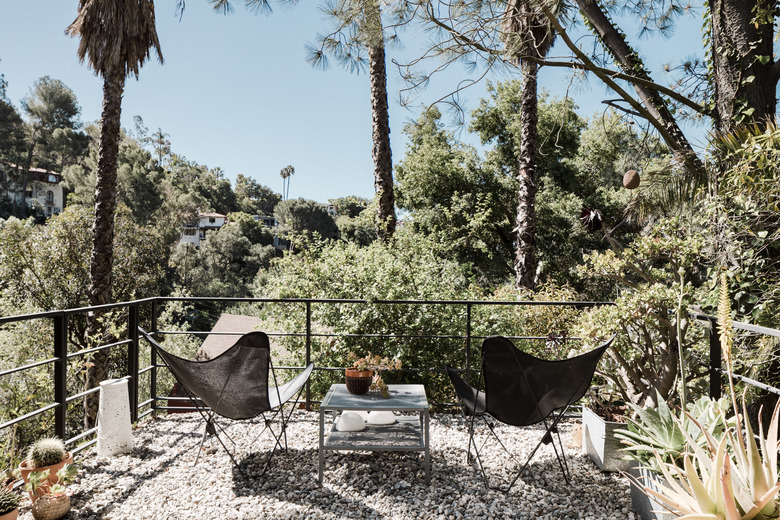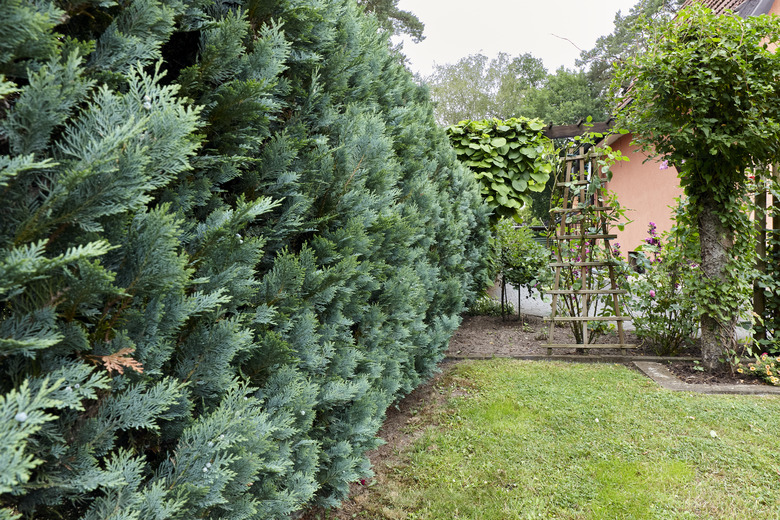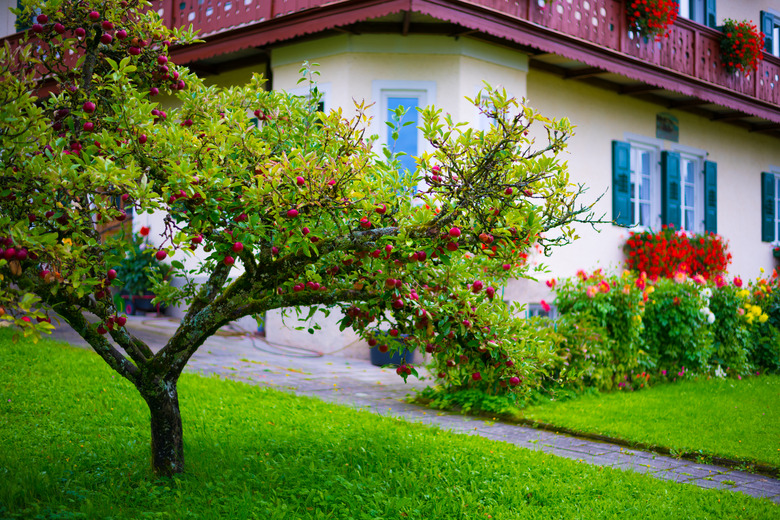Fast-Growing Trees For Privacy Screens
Everyone values privacy, and most homeowners automatically consider fencing when seeking a privacy screen to protect their yard and home from visual and physical intrusion, but there's a less expensive, more attractive option. Fast-growing, low-maintenance privacy trees can provide all the privacy of a fence without all the labor and expensive materials, and they add a living element to the landscape that attracts birds and wildlife. A living fence also provides shade for plantings, a pond or a sitting area and can be an effective windbreak that is even better than a wooden fence.
A living privacy screen takes time to get established, but you might be surprised by how little time is involved. Some of the most popular privacy trees grow as quickly as 3 feet a year, so you can have full privacy in two or three years instead of the 10 years you may have thought it would take. There's a tree for every size of yard, and most of the best privacy trees are readily available, grow almost anywhere and won't break your budget. In fact, they cost a fraction of what it would cost to build a fence.
Characteristics of Good Privacy Screen Trees
Characteristics of Good Privacy Screen Trees
The best trees for a privacy screen are evergreen trees, but several deciduous ones also qualify, although, as Savvy Gardening points out, you lose privacy every year in fall when deciduous trees drop their leaves. You also have the extra chore of raking those leaves every year, which can be time consuming if you have a long privacy fence. Evergreens with thick, dense branches that grow to a height of more than 6 feet make the best living fence, and there are some traits for which you should look:
- You can plant them close together. Trees that need a lot of room to grow may provide a certain amount of privacy by themselves, but they aren't the best trees for a privacy screen unless you do as Davey suggests and mix them with other species. No rule says all the trees in your privacy screen have to be the same species. You can also do as Country Living suggests and layer trees to create an impenetrable visual barrier, much like a shadowbox fence.
- They are low maintenance. Although regular watering will be needed until the trees are established, you want ones that can thrive without much water, pruning or fertilizing.
- They look beautiful. You want to add color and texture to your yard, not a bunch of spindly branches with sharp needles and no coloration.
- They grow tall enough to provide privacy. A good living fence grows tall enough to prevent anyone from peering over it. As a rule of thumb, privacy trees should grow to a height of at least 6 feet. Small trees that can be shaped into hedges are great if you're looking to demarcate a property line, but if you're looking for real privacy, taller is better.
Your location may limit your choice of privacy trees because some thrive in only a few of the United States Department of Agriculture (USDA) plant hardiness zones that span North America, but the good news is that some of the most popular specimens are hardy in a wide range of zones. They are, for the most part, fast-growing evergreen trees, but if you're looking for deciduous trees, one or two might fit your bill. Keep in mind that some fast-growing trees don't have time to develop strong trunks and branches, so they can be fragile, and they are often vulnerable to pests and disease.
3 Arborvitae Cultivars
3 Arborvitae Cultivars
Thuja Green Giant: The Green Giant arborvitae (Thuja 'Green Giant') is perhaps the best-known cultivar of Arborvitae (Thuja spp.), and it tops almost every list of popular privacy trees. It grows to a height of 40 to 60 feet and has a width at the base of 12 to 18 feet when mature. It's a perennial in USDA hardiness zones 5 to 8, which isn't as wide a range as some other species, but it makes up for that by being extremely fast-growing — adding as much as 3 feet per year, according to Gardening Know How — and requiring little maintenance. It likes full sun or partial shade and moderate moisture and can be planted 6 to 12 feet apart.
Emerald Green Thuja: If you prefer a privacy screen that isn't quite so dominant, consider the Emerald Green arborvitae (Thuja occidentalis 'Smaragd'). It reaches a maximum height of 15 feet and has a more slender base, with a width averaging 5 feet. Hardy in zones 4 to 8, Emerald Green Thuja saplings can be spaced 3 to 4 feet apart, and because they grow more slowly — only 6 to 9 inches per year, according to Budget Dumpster — they are easier to control and can be trimmed into hedges.
American Arborvitae: Homeowners living in regions too cold for the Thuja Green Giant or Emerald Green Thuja can get many of the same benefits by planting the American arborvitae (Thuja occidentalis), which is also commonly known as the eastern white cedar. Native to the northeast United States and Canada, it's a perennial in USDA zones 2 to 7 and features most of the benefits of its giant cousin, although it grows slightly more slowly, adding 1 to 2 feet of height per year. It's a low-maintenance evergreen that likes full sun or partial shade and moist soil, and it grows to a height of 40 to 60 feet.
Fast-Growing Leyland Cypress
Fast-Growing Leyland Cypress
The Leyland cypress (x Cupressocyparis leylandii) is a hybrid that grows even faster than the Green Giant arborvitae, and it's capable of adding 3 to 4 feet of height annually until it reaches maturity. It fares well in zones 6 to 10, and its growth rate is faster in southern climates. When the Leyland cypress grows in dry soil and gets about six hours of sunlight a day, it can reach a height of 70 feet and a spread of 20 feet if left to grow on its own. Nurslings should be spaced about 8 feet apart, which will allow them to grow into each other and produce a dense privacy hedge that you can shape at will since the trees can be pruned anywhere without damaging them.
Nellie Stevens Holly
Nellie Stevens Holly
Add color to your landscape with the dark-green foliage and red berries of Nellie Stevens holly (Ilex x 'Nellie R. Stevens'), which is a broadleaf evergreen shrub that grows to a height of 25 feet at a rate of 2 to 3 feet per year. When planted 5 to 6 feet apart, the Nellie Stevens holly will fill and create a dense, impassable barrier of spiky leaves. This plant grows best in zones 7 through 9 but will also do reasonably well in zone 6, although at a reduced growth rate.
If you're looking for a tall, dense yard border that says "keep out" with an air of sophistication and your property has well-drained soil and at least six hours of sunlight a day, Nellie Stevens holly is an excellent choice, especially when punctuated with the occasional Sky Pencil holly (Ilex crenata 'Sky Pencil'), which flourishes in the same conditions in zones 6 to 8. It's a columnar shrub that grows to 10 feet tall with only a 3-foot spread. Its leaves point upward, which keeps encroachment on its neighbors to a minimum.
Rough and Ready Eastern Redcedar
Rough and Ready Eastern Redcedar
A species of juniper, the eastern redcedar (Juniperus virginiana) is ubiquitous in open fields and along roadways in eastern North America, and while that may be a point against it, it indicates the tree's hardiness. Eastern redcedar is a cold-hardy perennial in zones 2 through 9 and in a variety of soil types, and it functions well as a windbreak, which is one reason it's so common. Many were planted in the 1930s to offset dustbowl conditions. It grows to a height of 20 to 50 feet and a spread of 8 to 20 feet at a rate of 1 to 2 feet per year, and its blue berries, which are characteristic of junipers, are an important source of food for birds and small animals.
Elegant Taylor Juniper
Elegant Taylor Juniper
The Taylor juniper (Juniperus virginiana 'Taylor') is a narrow, columnar evergreen that grows to a height of 18 feet with a spread of only 3 feet, but it grows quickly — as much as 3 feet per year. Taylor junipers are great trees for creating thin borders on property lines and can be planted close together or layered in alternate rows for a shadowbox effect. Hardy in zones 4 through 9, its blue-green foliage turns rust colored in winter, and together with its powdery-blue berries, it strikingly contrasts a blanket of snow.
Eastern White Pine for Shade
Eastern White Pine for Shade
The classic Christmas tree, the eastern white pine (Pinus strobus) is a perennial in zones 3 through 8 to a height between 50 and 80 feet and a spread between 20 and 40 feet at a rate of 12 inches a year. Eastern white pines make great shade trees and windbreaks as well as privacy fences, and they aren't picky about soil type, thriving in moist soil, rocky soil and ridges. They like a minimum of four hours of sunlight a day and do well in partial shade. The foliage consists of long, slender, green-blue needles that are soft and flexible.
Add Color With Wax Myrtle
Add Color With Wax Myrtle
Also known as southern bayberry, wax myrtle (Myrica cerifera) is a semievergreen shrub that is a popular privacy screen in zones 7 to 10, and because it can grow as fast as 3 to 5 feet per year, it's one of the best choices when you need a privacy screen in a hurry. It has large, waxy, fragrant leaves and bluish clusters of fruit that are popular with birds and other wildlife, and it produces slim, equally fragrant flowers in the spring. Wax myrtle can grow to a height of 25 feet (but it's usually shorter) and a spread of 6 to 10 feet. It's drought tolerant and thrives in full sun and a variety of soil types, preferring moist soil.
Fruit Trees for a Privacy Screen
Fruit Trees for a Privacy Screen
Fruit trees aren't usually regarded as privacy trees, but as noted by Gardening Know How, many fruit trees are actually shrubs, and it takes little effort to train them into a privacy hedge or windbreak. Candidates include peach, plum, pear, quince and crabapple, and you can mix and match species on a frame using a technique called "espalier." The best choice of tree depends on your climate zone, and this type of privacy screen may take longer to get established than some, but the abundance of fresh fruit on your table will make it worth the wait.
References
- Savvy Gardening: The Best Trees for Privacy in Big and Small Yards
- Davey: Fast-Growing Trees for Privacy (by Zone)
- Country Living: 10 Best Privacy Trees for Your Backyard
- Gardening Know How: Arborvitae Pros And Cons – Disadvantages And Benefits Of Arborvitae Trees
- Budget Dumpster: Best Trees for Privacy
- Gardening Know How: Using Fruit Trees As Hedges – Learn How To Use Fruit Trees For Hedges


